Examples of the use of ceramic materials in electrical engineering and electric power industry
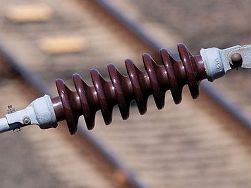 Ceramics - mixed and specially treated finely ground inorganic substances - is widely used in modern electrical engineering. The very first ceramic materials were obtained precisely by sintering powders, due to which a strong, heat-resistant, inert to most media, having low dielectric losses, resistant to radiation, capable of long-term work under conditions of variable humidity, temperature and pressure of the ceramic. And this is only part of the remarkable properties of ceramics.
Ceramics - mixed and specially treated finely ground inorganic substances - is widely used in modern electrical engineering. The very first ceramic materials were obtained precisely by sintering powders, due to which a strong, heat-resistant, inert to most media, having low dielectric losses, resistant to radiation, capable of long-term work under conditions of variable humidity, temperature and pressure of the ceramic. And this is only part of the remarkable properties of ceramics.
In the 50s, the use of ferrites (complex oxides based on iron oxide) began to grow actively, then they tried to use specially prepared ceramics in capacitors, resistors, high-temperature elements, for the manufacture of microcircuit substrates, and starting in the late 80s, in high-temperature superconductors . Later ceramic materials with the required properties ...
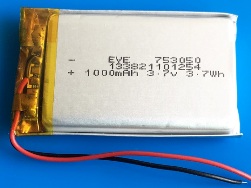 In the early 90s, when the industrial use of lithium-ion batteries was already gaining momentum, the first lithium batteries in the form of packages were developed - lithium-polymer batteries (designation “Li-Pol” or “Li-Po”). Thus, lithium polymer batteries have become a later type of lithium-ion battery. But if a liquid electrolyte is used in lithium-ion batteries, then in lithium-polymer counterparts this is already a polymer composition, in consistency it is a gel.
In the early 90s, when the industrial use of lithium-ion batteries was already gaining momentum, the first lithium batteries in the form of packages were developed - lithium-polymer batteries (designation “Li-Pol” or “Li-Po”). Thus, lithium polymer batteries have become a later type of lithium-ion battery. But if a liquid electrolyte is used in lithium-ion batteries, then in lithium-polymer counterparts this is already a polymer composition, in consistency it is a gel.
Due to the polymer base, batteries of this type have a higher specific energy intensity than others. It is for this reason that today lithium-polymer batteries are especially widely implemented in many mobile devices, where low weight is extremely important (gadgets, radio-controlled toys, etc.).A typical lithium polymer battery containsfour main parts in its design: anode, cathode, separator and electrolyte ...
 Earth's magnetic field is similar to the magnetic field of a giant permanent magnet, tilted at an angle of 11 degrees to the axis of its rotation. But there is a nuance, the essence of which is that the Curie temperature for iron is only 770 ° C, while the temperature of the Earth’s iron core is much higher, and only on its surface is about 6000 ° C. At such a temperature, our magnet would not be able to maintain its magnetization. So, since the core of our planet is not magnetic, terrestrial magnetism has a different nature. So, where does the Earth’s magnetic field come from?
Earth's magnetic field is similar to the magnetic field of a giant permanent magnet, tilted at an angle of 11 degrees to the axis of its rotation. But there is a nuance, the essence of which is that the Curie temperature for iron is only 770 ° C, while the temperature of the Earth’s iron core is much higher, and only on its surface is about 6000 ° C. At such a temperature, our magnet would not be able to maintain its magnetization. So, since the core of our planet is not magnetic, terrestrial magnetism has a different nature. So, where does the Earth’s magnetic field come from?
As you know, magnetic fields are surrounded by electric currents, so there is every reason to assume that the currents circulating in the molten metal core are the source of the earth's magnetic field. The shape of the Earth’s magnetic field is indeed similar to the magnetic field of a current loop.Magnitude measured on the surface of the earth ...
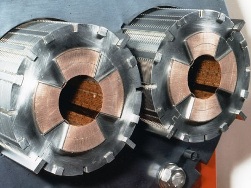 A superconducting magnet is an electromagnet whose winding has the property of a superconductor. As in any electromagnet, the magnetic field is generated here by direct current flowing through the winding wire. But since the current passes in this case not through an ordinary copper conductor, but through a superconductor, the active losses in such a device will be extremely small.
A superconducting magnet is an electromagnet whose winding has the property of a superconductor. As in any electromagnet, the magnetic field is generated here by direct current flowing through the winding wire. But since the current passes in this case not through an ordinary copper conductor, but through a superconductor, the active losses in such a device will be extremely small.
As superconductors for magnets of this type, superconductors of the second kind almost always act, that is, those in which the dependence of magnetic induction on the strength of the longitudinal magnetic field is nonlinear. In order for a superconducting magnet to begin to show its properties, ordinary conditions are not enough - it must be brought to a low temperature, which in principle can be achieved in various ways.The classic way is this: the device is placed in a Dewar vessel with liquid helium, and the Dewar vessel itself ...
Levitation and the Biffeld-Brown effect, ionic wind - how it works
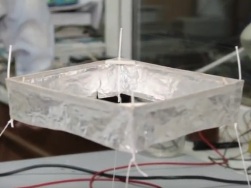 Aluminum food foil and the finest copper wire, and between them - only 3 centimeters of air. The foil and wire are mounted on a square dielectric frame made of light plastic sticks. The design rests on the table, and like any object, gravity acts on it from the side of the Earth. But it is worth creating a potential difference of several thousand volts between the foil and the wire, applying a high constant voltage of about 30,000 volts from a low-power source to it, as the structure takes off, as if by magic.
Aluminum food foil and the finest copper wire, and between them - only 3 centimeters of air. The foil and wire are mounted on a square dielectric frame made of light plastic sticks. The design rests on the table, and like any object, gravity acts on it from the side of the Earth. But it is worth creating a potential difference of several thousand volts between the foil and the wire, applying a high constant voltage of about 30,000 volts from a low-power source to it, as the structure takes off, as if by magic.
We are not talking about a take-off capacitor, because the plates, if you can call them that at all, almost do not overlap each other in any significant fraction of their areas, which means that practically no energy accumulation in the dielectric between the "plates" occurs. If the structure did not hold the thinnest strong strings on the table, it would continue its progressive movement ...
Why are the wires of the power lines noisy
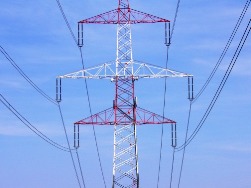 Why are the wires of the power line humming? Have you ever thought about this? But the answer to this question can be by no means trivial, although completely unsophisticated. Let's look at several explanations, each of which has a right to exist.
Why are the wires of the power line humming? Have you ever thought about this? But the answer to this question can be by no means trivial, although completely unsophisticated. Let's look at several explanations, each of which has a right to exist.
Most often they bring such an idea. An alternating electric field near the power line wire electrifies the air around the wire, accelerates free electrons, which ionize the air molecules, and they in turn generate a corona discharge. And now, a corona discharge around the wire lights up and goes out 100 times per second, while the air near the wire heats up - cools down, expands - contracts, and in this way we get a sound wave in the air, which our ear perceives as a buzzing wire. Still there is such an idea. The noise comes from the fact that an alternating current with a frequency of 50 Hz produces an alternating magnetic field ...
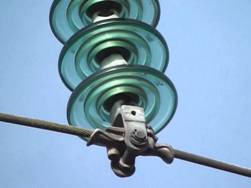 From time to time on the Internet you can find reports about how one of the cyclists was hurt by electric shock from his own bicycle when he was driving under a high-voltage power line with a voltage of 100 kV or more. No one can give exact and intelligible answers to such requests: disputes on this issue arise on the forums every now and then, however, many users of the network have guesses on this subject.
From time to time on the Internet you can find reports about how one of the cyclists was hurt by electric shock from his own bicycle when he was driving under a high-voltage power line with a voltage of 100 kV or more. No one can give exact and intelligible answers to such requests: disputes on this issue arise on the forums every now and then, however, many users of the network have guesses on this subject.
It’s one thing when it comes to step voltage, it would be quite understandable if the wire detached from the power line were in contact with the ground, and then standing on the ground someone could accidentally find themselves in the wrong place at the wrong time dangerous step voltage. This is a well-known phenomenon, for its reason in 1928 three horses died on the Leningrad pavement in one day. But in the messages given by the cyclists, the speech about the step voltage does not seem to go ...
What is battery capacity and what does it depend on
 Looking at the markings of any modern battery, whether it’s a lithium-ion cell phone battery or a lead-acid battery from an uninterruptible power supply, we can always find there information not only about the rated voltage of this power source, but also about its electric capacity.
Looking at the markings of any modern battery, whether it’s a lithium-ion cell phone battery or a lead-acid battery from an uninterruptible power supply, we can always find there information not only about the rated voltage of this power source, but also about its electric capacity.
Typically, these are numbers like: 2200 mAh (read as 2200 milliampere-hours), 4Ah (4 ampere-hours), etc. As you can see, a non-system unit of measurement - Ah (Ampere hour) - “ampere- hour ", and not at all" farad "as for capacitors. And the clock here does not appear for a reason, but for the reason that a regular battery, unlike a conventional capacitor, is able to power the load literally for hours.If you try to explain quite simply, then the battery capacity in ampere-hours is a numerical expression of how long this battery is ...
